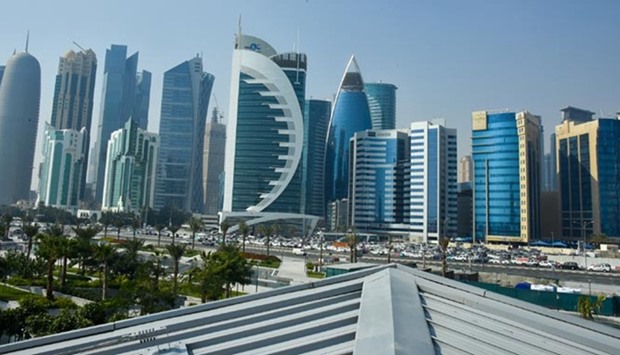Qatar’s public debt has been forecast to fall to 45.6% of the country’s GDP by 2024 from 52.6% this year, FocusEconomics has said in a report.
The country public debt as a percentage of the country’s gross domestic product (GDP) will fall continuously over the next four years, the researcher said.
It is projected at 51.7% next year, 49.6% (2022) and 47.6% in 2023.
Qatar’s GDP has been estimated to reach $236bn by 2024 from $198bn this year, the new report has shown.
Next year, it will be $206bn, $215bn (2022) and $225bn in 2023.
GDP per capita, FocusEconomics said, has been estimated to reach $84,600 in 2024 from $71,679 this year.
Qatar’s economic growth in terms of nominal GDP will reach 4.9% in 2024 from 3.2% by the year-end.
The country’s fiscal balance as a percentage of GDP is set to rise to 4.8% in 2024 from an estimated 0.8% this year.
Qatar’s merchandise trade balance will scale up further and exceed $61.3bn in 2024, the report said.
This year, FocusEconomics has projected the merchandise trade balance at nearly $40.4bn. Next year, it will account for $41.6bn, $46.4bn (2022) and $52.8bn in (2023).
The current account balance (as a percentage of GDP) will be 4.6% in 2024 compared with 3.9% in 2020, 4.3% (2021 and 2022) and 4.5% in 2023.
International reserves may exceed $37.5bn in 2024, from $39.4bn this year; FocusEconomics estimated it will cover 10.6 months of country’s imports by then.
The country’s inflation, the report noted, will be 2% in 2024 and 1.1% this year.
Qatar’s unemployment rate (as a percentage of active population) will remain a meagre 0.2% in 2024, unchanged from this year.
According to FocusEconomics, the economy “likely remained subdued” in the fourth quarter of last year.
Turning to the first quarter of this year, the economic panorama is likely more or less stable.
The non-oil private sector PMI averaged higher in January–February than in Q4 but “remained tepid” nonetheless. Moreover, private sector credit growth surged in January. Nevertheless, merchandise exports continued to contract in January, while the coronavirus will be weighing heavily on tourist arrivals and thus private consumption in the first quarter.
Qatar’s economic growth is expected to “accelerate” this year due to stronger government consumption and as the Barzan gas facility comes online.
Investment in the expansion of the North Field gas project should also support growth.
“Geopolitical tensions, coronavirus and volatile commodity prices remain downside risks to the outlook, however.
FocusEconomics panelists see growth of 2% in 2020, which is down 0.1 percentage points from last month’s forecast, and 2.5% in 2021.
Consumer prices fell 0.4% in annual terms in January, stronger than December’s 0.3% decline.
Inflation should return this year on a “more favourable base effect, looser financial conditions and stronger economic activity.”
Recently, QCB cut its deposit rates by 50 basis points, echoing the Fed’s rate cut the day prior.
FocusEconomics see average consumer prices increasing 1.1% in 2020, which is down 0.1 percentage points from last month’s forecast. In 2021, it sees inflation averaging 1.4%.
ends
It is projected at 51.7% next year, 49.6% (2022) and 47.6% in 2023.
Qatar’s GDP has been estimated to reach $236bn by 2024 from $198bn this year, the new report has shown.
Next year, it will be $206bn, $215bn (2022) and $225bn in 2023.
GDP per capita, FocusEconomics said, has been estimated to reach $84,600 in 2024 from $71,679 this year.
Qatar’s economic growth in terms of nominal GDP will reach 4.9% in 2024 from 3.2% by the year-end.
The country’s fiscal balance as a percentage of GDP is set to rise to 4.8% in 2024 from an estimated 0.8% this year.
Qatar’s merchandise trade balance will scale up further and exceed $61.3bn in 2024, the report said.
This year, FocusEconomics has projected the merchandise trade balance at nearly $40.4bn. Next year, it will account for $41.6bn, $46.4bn (2022) and $52.8bn in (2023).
The current account balance (as a percentage of GDP) will be 4.6% in 2024 compared with 3.9% in 2020, 4.3% (2021 and 2022) and 4.5% in 2023.
International reserves may exceed $37.5bn in 2024, from $39.4bn this year; FocusEconomics estimated it will cover 10.6 months of country’s imports by then.
The country’s inflation, the report noted, will be 2% in 2024 and 1.1% this year.
Qatar’s unemployment rate (as a percentage of active population) will remain a meagre 0.2% in 2024, unchanged from this year.
According to FocusEconomics, the economy “likely remained subdued” in the fourth quarter of last year.
Turning to the first quarter of this year, the economic panorama is likely more or less stable.
The non-oil private sector PMI averaged higher in January–February than in Q4 but “remained tepid” nonetheless. Moreover, private sector credit growth surged in January. Nevertheless, merchandise exports continued to contract in January, while the coronavirus will be weighing heavily on tourist arrivals and thus private consumption in the first quarter.
Qatar’s economic growth is expected to “accelerate” this year due to stronger government consumption and as the Barzan gas facility comes online.
Investment in the expansion of the North Field gas project should also support growth.
“Geopolitical tensions, coronavirus and volatile commodity prices remain downside risks to the outlook, however.
FocusEconomics panelists see growth of 2% in 2020, which is down 0.1 percentage points from last month’s forecast, and 2.5% in 2021.
Consumer prices fell 0.4% in annual terms in January, stronger than December’s 0.3% decline.
Inflation should return this year on a “more favourable base effect, looser financial conditions and stronger economic activity.”
Recently, QCB cut its deposit rates by 50 basis points, echoing the Fed’s rate cut the day prior.
FocusEconomics see average consumer prices increasing 1.1% in 2020, which is down 0.1 percentage points from last month’s forecast. In 2021, it sees inflation averaging 1.4%.
ends


